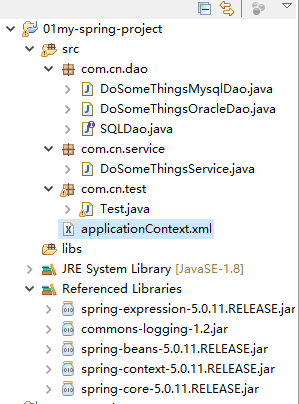spring3--IOC(xml配置注入)
sring的配置文件及jar包说明
applicationContext.xml 是spring的配置文件。spring是管理Bean的。所以主要是配置Bean,xml的根节点是Beans。
bean节点:由spring框架创建管理的Jave对象成为Bean
bean节点的属性id:表示对象的名称,唯一值。spring在创建完对象之后,就是赋值给名为id的引用类型。
bean节点的属性class:java对象的全限定类型,不能是接口,要是可以创建的类。(框架使用反射创建对象)
使用spring的最小的jar包:
spring-expression-5.0.11.RELEASE.jar //表达式 commons-logging-1.2.jar //引用的外部日志包 spring-beans-5.0.11.RELEASE.jar //核心bean包 spring-context-5.0.11.RELEASE.jar //核心包 spring-core-5.0.11.RELEASE.jar //核心包
一个spring demo
ApplicationContext 接口,是spring的容器对象。它的实现类有 ClassPathXmlApplicationContext 和 FileSystemXmlApplicationContext。
两者的区别在于:配置文件所放的位置不同。ClassPathXml 一般表示类路径相关。FileSystemXml 磁盘目录,项目根目录。
代码结构:

关键类代码:
package com.cn.dao; public interface SQLDao { public void insert(); } package com.cn.dao; public class DoSomeThingsMysqlDao implements SQLDao{ public void insert(){ System.out.println("do insert"); } } package com.cn.dao; public class DoSomeThingsOracleDao implements SQLDao{ public void insert(){ System.out.println("oracle do insert"); } } package com.cn.service; import com.cn.dao.DoSomeThingsOracleDao; public class DoSomeThingsService { private DoSomeThingsOracleDao dao; public void add(){ System.out.println("service do insert"); dao.insert(); } public DoSomeThingsOracleDao getDao() { return dao; } public void setDao(DoSomeThingsOracleDao dao) { this.dao = dao; } } package com.cn.test; import org.springframework.context.ApplicationContext; import org.springframework.context.support.ClassPathXmlApplicationContext; import com.cn.service.DoSomeThingsService; public class Test { public static void main(String[] args) { String resource = "applicationContext.xml";
//ApplicationContext 接口,是spring的容器对象。它的实现类有 ClassPathXmlApplicationContext 和 FileSystemXmlApplicationContext。
//两者的区别在于:配置文件所放的位置不同。ClassPathXml 一般表示类路径相关。FileSystemXml 磁盘目录,项目根目录。
ApplicationContext ac = new ClassPathXmlApplicationContext(resource); DoSomeThingsService service= (DoSomeThingsService) ac.getBean("doSomeService"); service.add(); } }
配置文件:
<?xml version="1.0" encoding="UTF-8"?> <!-- 增加约束文件 --> <beans xmlns="http://www.springframework.org/schema/beans" xmlns:xsi="http://www.w3.org/2001/XMLSchema-instance" xsi:schemaLocation="http://www.springframework.org/schema/beans http://www.springframework.org/schema/beans/spring-beans.xsd" >
<!-- id 表示对象的名称,唯一值。spring在创建完对象之后,就是赋值给名为id的引用类型。 -- >
<!-- java对象的全限定类型,不能是接口,要是可以创建的类。(框架使用反射创建对象) -->
<bean id="doSomeDao" class="com.cn.dao.DoSomeThingsOracleDao"/> <bean id="doSomeService" class="com.cn.service.DoSomeThingsService" > <property name="dao" ref="doSomeDao" /> </bean> </beans>
结果输出:

JavaBean的装配及其作用域,始末方法
Bean的装配就是,创建Bean对象,并给对象的属性赋值。
默认的装配方式:
调用类的无参构造方法。
JavaBean的五个作用域:
singleton:单例模式。通过spring Ioc容器来管理bean,使用singleton定义的Bean从始至终将只有一个实例对象。
prototype:原型模式。定义为prototype的bean, 每次通过容器的getBean方法获取时,都将产生一个新的Bean的实例。
request:(在web项目使用spring时有效) 每次http请求将会产生不同的Bean实例
session:(在web项目使用spring时有效) 对于每次http session,使用session定义的bean都将产生一个新的实例
globalsession:(在web项目使用spring时有效) global session作用域类似于标准的HTTP Session作用域,不过它仅仅在基于portlet的web应用中才有意义。Portlet规范定义了全局Session的概念,它被所有构成某个portlet web应用的各种不同的portlet所共享。在global session作用域中定义的bean被限定于全局portlet Session的生命周期范围内。
常用的就是singleton 和 prototype。
如果不指定Bean的作用域,Spring默认使用singleton作用域。
Java在创建Java实例时,需要进行内存申请;销毁实例时,需要完成垃圾回收,这些工作都会导致系统开销的增加。
因此,prototype作用域Bean的创建、销毁代价比较大。
而singleton作用域的Bean实例一旦创建成功,可以重复使用。
在DoSomeThingsOracleDao 增加构造函数 public DoSomeThingsOracleDao() { System.out.println("dao construction"); } 在 DoSomeThingsService 增加构造函数 public DoSomeThingsService() { System.out.println("DoSomeThingsService construction"); } 定义的始末方法 public void destroyA() { System.out.println("DoSomeThingsService destroy method"); } 测试方法如下 public static void main(String[] args) { String resource = "applicationContext.xml"; ApplicationContext ac = new ClassPathXmlApplicationContext(resource); DoSomeThingsService service= (DoSomeThingsService) ac.getBean("doSomeService"); DoSomeThingsService service2= (DoSomeThingsService) ac.getBean("doSomeService"); } dao construction //dao 是singleton 的,在初始化容器的时候创建 DoSomeThingsService construction //Service 是 prototype 的 ,每次getbean时创建一次。
DoSomeThingsService init method
DoSomeThingsService construction
配置文件如下:
<?xml version="1.0" encoding="UTF-8"?> <!-- 增加约束文件 --> <beans xmlns="http://www.springframework.org/schema/beans" xmlns:xsi="http://www.w3.org/2001/XMLSchema-instance" xsi:schemaLocation="http://www.springframework.org/schema/beans http://www.springframework.org/schema/beans/spring-beans.xsd" > <bean id="doSomeDao" class="com.cn.dao.DoSomeThingsOracleDao" /> <!-- 1.bean标签的属性说明。 bean表示注册一个java bean对象。 id 表示容器创建对象之后 赋值给名为id的引用对象。 class 注册是类。全限定类名。 2.bean的作用域的说明。 scope 类的作用域。singleton,prototype,request,session,globalsession。 单例模式singleton的类,都是在容器初始化的时候创建的 prototype原型模式,是在 getBean的时候创建的。 3.bean的初始方法和 结束方法的定义。 init-method 方法原型: public void 自定义方法名(){}; destroy-method 方法原型: public void 自定义方法名(){}; --> <bean id="doSomeService" class="com.cn.service.DoSomeThingsService" destroy-method="destroyA" init-method="initA" scope="prototype"> <property name="dao" ref="doSomeDao" /> </bean> </beans>
上述例子说明了:
1.单例模式singleton的类,都是在容器初始化的时候创建的。原型模式,是在 getBean的时候创建的。
2.单例模式在容器中,始终只有一个。原型模式每次getBean新建一个。
3.bean的初始化方法,在创建对象的时候,执行完构造函数之后执行。
修改配置文件及测试方法如下:
<bean id="doSomeService" class="com.cn.service.DoSomeThingsService" destroy-method="destroyA" init-method="initA"> <property name="dao" ref="doSomeDao" /> </bean> public static void main(String[] args) { String resource = "applicationContext.xml"; ApplicationContext ac = new ClassPathXmlApplicationContext(resource); DoSomeThingsService service= (DoSomeThingsService) ac.getBean("doSomeService"); ClassPathXmlApplicationContext cpac = (ClassPathXmlApplicationContext)ac; cpac.close(); }
dao construction
DoSomeThingsService construction
DoSomeThingsService init method
七月 21, 2019 8:40:24 下午 org.springframework.context.support.ClassPathXmlApplicationContext doClose
信息: Closing org.springframework.context.support.ClassPathXmlApplicationContext@6193b845: startup date [Sun Jul 21 20:40:24 CST 2019]; root of context hierarchy
DoSomeThingsService destroy method
说明:只有单例模式的对象,在容器关闭的时候会执行销毁方法。
类型注入的例子
给DoSomeThingsService 增加int的属性 private int intValue; 增加get,set方法。 配置文件 修改如下 <bean id="doSomeService" class="com.cn.service.DoSomeThingsService" destroy-method="destroyA" init-method="initA"> <property name="dao" ref="doSomeDao" /> <property name="intValue" value="5" /> </bean> 测试代码: public static void main(String[] args) { String resource = "applicationContext.xml"; ApplicationContext ac = new ClassPathXmlApplicationContext(resource); DoSomeThingsService service= (DoSomeThingsService) ac.getBean("doSomeService"); System.out.println(service); } 输出: DoSomeThingsService init method DoSomeThingsService [intValue=5]
引用类型还可用如下方式注入
<bean id="doSomeService" class="com.cn.service.DoSomeThingsService" destroy-method="destroyA" init-method="initA"> <!-- <property name="dao" ref="doSomeDao" /> --> <property name="dao"> <ref bean="doSomeDao"/> </property> <property name="intValue" value="5" /> </bean>



 浙公网安备 33010602011771号
浙公网安备 33010602011771号